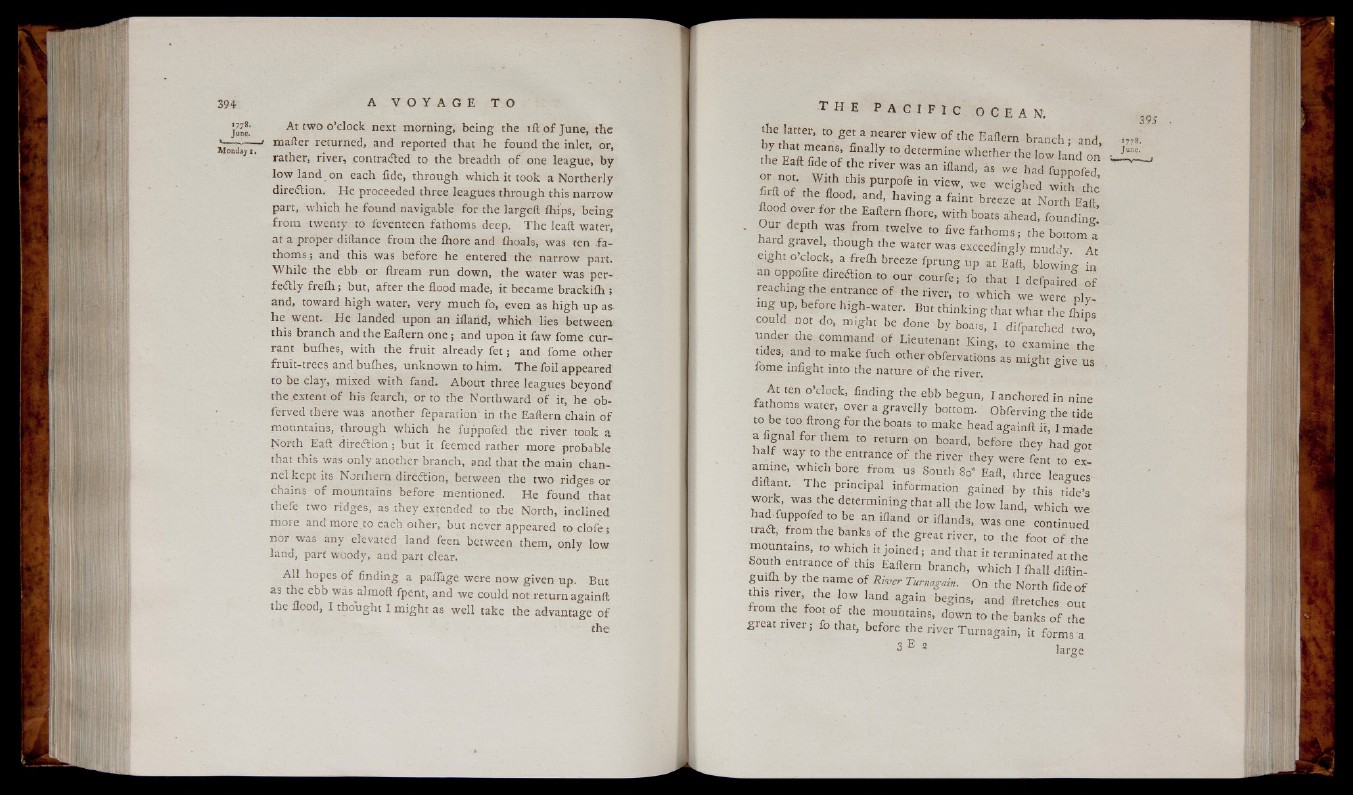
jun*’ At two o’clock next morning, b e in g the lit o f June, the
s— — » mailer returned, and reported that he found the inlet, or.
Monday i* « . * *
rather, river, contracted to the breadth o f one leagu e, b y
low land on each fide, throu gh which it took a Northerly
direction. He proceeded three leagues through this narrow
part, which he found navigable for the largeft fhips, being
from twenty to feventeen fathoms deep. T h e leaft water,
at a proper diftance from the Ihore and Ihoals, was ten f a thoms
; and this was before he entered the narrow part.
W h ile the ebb or ilream run down, the water Was perfe
c tly f r e ih ; but, after the flood made, it became brackiih ;
and, toward h ig h water, very much fo, even as h igh up as
h e went. He landed upon an iflatid, which lies between
this branch and the Eallern one ; and upon it faw fome currant
bufhes, with the fru it already f e t ; and fome other
fruit-trees and buihes, unknown to him. T h e foil appeared
to be clay, mixed w ith fand. About three leagues beyond
the extent o f his fearch, or to the Northward o f it, he ob-
ferved there was another foparation' in the Eallern chain o f
mountains, through which he luppofod the river took a
North Eaft d irection ; but it feemed rather more probable
that this was only another branch, and that the main channel
kept its Northern diredtion, between the two ridges or
chains o f mountains before mentioned. He found that
thefe two ridges, as they extended to the North, inclined
more and more to each other, but never appeared to clofe ;
nor was any elevated land feen between them, only low
land, part woody, and part clear.
A ll hopes o f finding a paiiage were now given up. But-
as the ebb was almoft fpent, and we could not return againlt
the flood, I thought I migh t as w e ll take the advantage o f
the
Z \ l T L t0 S £ a r re7 iew 0f the Eaftern branch ; and, p t .
th e E a f tM f f P S I determine whether the low land on
the Eaft fide o f the river was an ifland, as we had fuppofed
or not. With this purpofe in view, we weighed K
firft o f the flood, and, ha vin g a faint breeze at North Eaft
1 b o ..s ahead, I g S
' h a r f t r 1 lWK fT , tWdVe t0 five fathomS;h a id gravel, though the water was exceedingly tmheu dbdotyt omA at
C t O’d o c k , a freih breeze fprung up at EM blowing fo
an oppofite diredlion to our courfe; fo that I defpaired o f
reaching the entrance o f the river, to which we were ply in
g up, before high-water. But thinking that what the ihips
could not do, might be done by boars,. I difpatched two
under the, command o f Lieutenant King, to examine the
tides, and to make fuch other obfervations as might give us
fome infight into the nature o f the river.
At ten o’clock, finding the ebb begun, I anchored in nine
fathoms water, over a gravelly bottom. Obferving the tide
to be too ftrong for the boats to make head againft ft, I made
a fignal for them to return on board, before they had got
h a lf w ay to the entrance o f the river they were font to examine,
which bore from us South 80* Eaft, three leagues
diftant. T he principal information gained by this tide’s
work was the determining that all the low land, which we
hadTuppofed1 to be an ifland or iflands, was one continued
, from the banks o f the great river, to the foot o f the
mountains, to which it jo in ed ; and that it terminated at the
uth entrance o f this Eaftern branch, which I ihall diilin-
g u iih by the name o f River Turnagain. On the North fide o f
this river the low land again begins, and ftretches out
rom the foot o f the mountains, down to the banks o f the
great riv er ; fo that, before the river Turnagain, it forms a
3 ^ 3 large